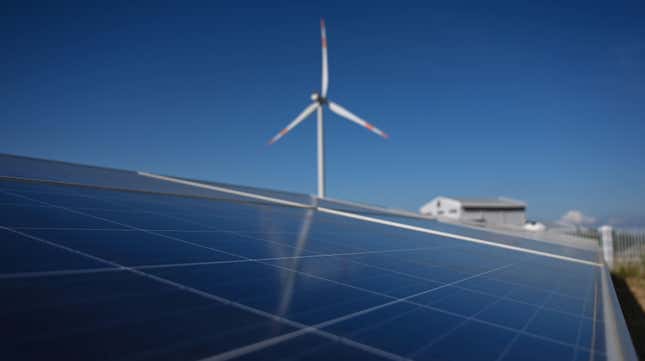
Right now, just 17% of the world’s energy comes from renewable sources. The lion’s share still comes from planet-warming fossil fuels. It’s clear that we have to change that ratio quickly in order to curb greenhouse gas emissions and slow the climate crisis.
Building infrastructure for renewable energy requires intensive mining for metal to build wind turbines, solar panels, and other infrastructure. If not done carefully, the rush to build out renewables could pose a huge threat to biodiversity. In a study published in Nature Communications on Tuesday, scientists focused on one impact in particular: habitat loss caused by the expansion of mining operations.
The authors pinpointed mining areas around the world for 40 key materials needed to produce renewable energy. On the list were bulk metals such as iron and aluminum, minerals more traditionally produced in smaller quantities such as cobalt and lithium, and specialty rare earth elements used to produce specific elements of renewable technology such as scandium.
They found that between currently operating sites and planned ones, mining influences nearly 20 million square miles (50 million square kilometers) of the Earth’s land surface. Eight-two percent of those mining areas target materials that are used in renewable energy production. To see how these mining sites could destroy crucial habitats, the researchers then overlaid their map of current and planned mining sites with a map of areas governments have deemed important for habitat conservation. The research breaks down those conservation areas as already protected areas, key locations for biodiversity, and places that are considered wilderness.

The coincidence of the two maps paints a scary picture. The authors found that 8% of current and planned mining areas overlap with nationally designated protected areas, 7% with key biodiversity areas, and 16% with remaining wilderness sites, which are considered important priorities for halting biodiversity loss.
“These places occur globally and are considered critical to the survival of many species already threatened by other stressors, like climate change,” Laura Sonter, lead author of the new study and Research Fellow at the University of Queensland, Brisbane, said in an email. “Mining in these place could add even more pressure.”
When examining pre-operational mines specifically, the authors also found that the ones planned for renewable materials appear to be more densely packed together than those targeting other materials. Sonter said this is troubling.
“An increasing number of mines operating in a region may have a larger cumulative impact on biodiversity than that of a single mine,” she said, “although more research is needed to demonstrate this occurs in practice.”
The ecological consequences of extracting minerals used in renewable energy technology can already be seen in parts of the world. In West Africa’s Republic of Guinea, a Mongabay report found that bauxite (the source of most aluminum) mining poses a serious risk to populations of endangered western chimpanzees. And in Indonesia’s island of Sulawesi, Mongabay found that a nickel mine has caused habitat degradation, putting pressure on species like the critically endangered crested black macaque monkey.
Without careful planning, we’ll likely see more of this in the future. Metal mines are currently in the works for biodiverse regions such as the Democratic Republic of Congo, which is home to lush jungles full of apes and elephants, and parts of Madagascar that are home to the endangered Mittermeier’s sportive lemur. But if we consider these risks, we can minimize this harm.
An important way to shrink renewable energy’s ecological footprint is to boost efficiency, which reduces the amount of materials needed. Renewable industries can also work to recycle as many materials as possible. Policymakers should also set up clear boundaries for areas that can’t be touched by mines, the new study’s authors say. These types of policies are crucial because we can’t solve the climate crisis by worsening the ecological one unfolding.
“The good news is that our study suggests many of the required materials also exist outside areas important for biodiversity,” said Sonter. “To avoid the potential trade-offs between producing renewable energy and conserving species and ecosystems, we need to identify the sites and species most at risk and ensure new mines don’t inadvertently lead to their extinction.”